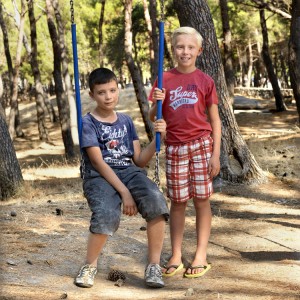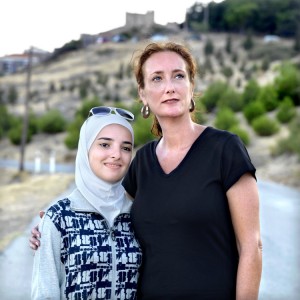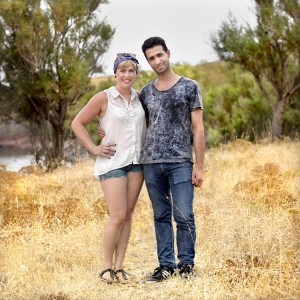The Island of All Together: Conversations on Lesvos [interview]
Every summer many European tourists travel to the Greek island of Lesvos for a sunny holiday. Since last year thousands of refugees have crossed the sea from Turkey to the island, looking for a safe haven in the European Union. Filmmakers Philip Brink and Marieke van der Velden invited tourists and refugees to talk to one another about life, while sitting on a little bench overlooking the sea. The result is a short documentary, entitled “The Island of All Together”, with conversations of war, fleeing, home, work, love, but also cars and pets.
Interview to Eleftheria Pantziou
What motivated you make this film?
Philip: I am an art director and Marieke is a photographer. In our daily lives we take commercial assignments for companies and NGOs but once a year we combine our powers and make our own projects. In this project we wanted to add a new aspect to the images we see everyday in the news. If you you’ve got an assignment as a photographer, whether it’ s an advertisement or a story, you tend to come home with certain kinds of images. In the news we are always looking for extreme images or extreme stories, but we miss the everyday life. If you try to understand the world we live in, it’s kind of hard to only have extreme images. You try to understand other countries, other people and the only thing you know about them are very brief moments of bomb blasts or the moments refugees arrive on the beach. Our main goal while making our own projects is to add new images! We’ve done it before in Lebanon and Afghanistan, and now on Lesvos.
When we came back from Lebanon, there were people crossing the sea, but the flows were not as increased as today. We had met a Syrian refugee who worked in a restaurant there. We became friends on Facebook and we started communicating. One morning he sent us a text message that he was on the island of Kos in the Aegean. So, suddenly we knew somebody, a person with whom we had met and talked. He had crossed the sea and the refugee crisis suddenly became very personal to us. We thought that maybe we should start telling this story as well.
There was a great opportunity on Lesvos to bring people together, that would normally never see or talk to each other: The Syrian refugees and the tourists.
Marieke: We started following him also because he was sending us photos and we had a sort of a real time documentary on our hands. He was sending information, selfies and short videos from the places he’d been like the Hungarian border.
Philip: There were some people that had seen our previous projects and said they wanted to support our next one, so these things came together and we decided to go to Lesvos. We wanted our documentary to be personal. On the Lebanon project, we had gathered questions from our Facebook friends and we asked the people on behalf of them. It was an effort to connect people one on one. It was really powerful!
On Lesvos you had two people talking to each other and in fact telling their own story, correct?
Philip: We found out that there was a great opportunity to bring people together on Lesvos that would normally never see or talk to each other: The Syrian refugees and the tourists. The idea was to ask them to talk to each other, while we were filming and taking pictures.
Marieke: We started producing it and then we went to Lesvos. We had a sound engineer with us and a translator who translated on the sport and the rest we did ourselves.

How did people feel about participating? Did you have many volunteers?
Marieke: In the beginning I asked four, young tourists from Holland and they said “no”, which was really difficult, but later on people started saying “yes” because they got curious. We were showing them the interviews we’d done until then and the set, which was really simple because we wanted them to feel comfortable.
Philip: The most difficult part was to take two people on the same place at the same time, because the Syrians did not have much time. They would arrive on the beach and then they’d walk to the village and take the bus to Mytilene. They would only be there for a few hours. So, we would find the tourist first, set the appointment and then, just before filming we would go and ask refugees and take them to the scene. The conversation was between two people, that had never met before and did not know anything about each other. It was a surprise for us that they’d sit down, greet each other and start talking!
… and some of them really connected, even though they were very different!
Marieke: Our way of filming couldn’t afford any mistakes. So, we asked them to be themselves, make the questions and if the other person did not want to answer then he/she could just be honest and say it! People felt comfortable and this was very important for us.
Philip: There was awkwardness at first but then, they would start talking with the help of the translator and the question cards. When things were getting difficult we would help by asking them to pick a new card. The questions were really simple.
I felt awkward as a viewer sometimes but this was not the case for the people that participated…
Philip: This is true. It is the viewer that is feeling awkward at times but not the people on the documentary. This is, I think because we took people on a neutral spot to talk to each other – not the beach for example at the moment refugees arrive. They would sit down and just talk to each other. It was sort of an equal conversation.
Marieke: Like Rashad (Syrian) and Ottis (Netherlands). One asked “what would you do if you had a million dollars”. Ottis said he’d buy a new car and spent the rest to his studies. And Rashad said: “I hope God gives you a very nice car”. Rashad was not angry or jealous. He immediately felt that he was talking to a 19 year old boy. Ottis was just very honest and Rashad was like a father to him!

How did you feel while making the documentary?
Marieke: Every report I make, there is always an emotional moment. I am always trying to make projects that will help me understand the world a little bit better. I’ve travelled a lot with NGOs and I’ve seen things. For example in Afghanistan: When I arrived it was just a country. Then I met the people of the country, and the country got a face.
You know we tend to talk so easily about the people in Afghanistan or the refugees from our comfort zone – our home and this hurts me.
We arrived on Lesvos and we started working a lot, but on the last day we had two little guys that were not in the film and also Alaa (from Syria) and Finn (from the UK) that were in the film and behind the cameras the boys’ two fathers. After we finished filming the father of Alaa started crying, he became very emotional and he said: “You don’t know what we are going through. We’ve fought so much! Now I am here, you’re very nice. I see my son sitting on the swing with another boy who has all the chances and my son is just a refugee who has lost everyting”. That was a moment we all started crying, a very hard moment!
Philip: When filming you get in a production mode. During the first day on Lesvos we started looking around, helping the volunteers but at some point we had to stop doing voluntary work and start filming. Our car was used by the volunteers, we got it back and started working. So, you create some kind of distance, being behind the camera.
It was also interesting and emotional because we were in Greece, in Europe, which is kind of “our” world, the place we go on holiday! And this is also the place were all refugees arrive in such difficult circumstances! Again we came very close. It was very emotional to see two worlds coming together: The tourists and the refugees!
Marieke: When we got home and we started editing the documentary, I cried a lot!
Philip: That was my way of testing that we had something (laughs). We don’t want to make people cry but it was interesting to see the impact.

But again you wanted your documentary to move people.
Philip: Yes, but when editing the film we did not choose only the emotional moments. In general the film makes people emotional.
Marieke: Our goal was to move people. We get a lot of e-mails from people from all over the world, since the documentary is available with subtitles in 9 languages (Greek, English, Portuguese, Spanish, Italian, French, Dutch, German, Arabic). People really get the message! They understand that these are people that have lost everything, not just a group of refugees.
It is also the difference in cultures. For example Dutch Petra asked Syrian Suhaila: “Will you have an arranged marriage? The Dutch, you know, are very direct but in Syria of course things are different. Suhaila took the question quite well and she started to explain, but at first she was shocked!
Are you planning to submit the documentary at international and Greek film festivals?
Philip: We have and we will. We uploaded the documentary on-line once it was completed because we wanted it to be seen by as many people as possible. We’ve had a lot of attention on-line. It was our choice to make it public for everyone to have access to it. And we really want the Greeks to watch it, that’s why it is also available with Greek subtitles.
When we were on Lesvos, we saw a nice open air cinema. We’d really like to go back and present it there.

All participants kept contact through the social media, which is amazing…
Philip: All the people we met on Lesvos where middle class, but they were fleeing a war. Everybody had a smartphone and they were contacting their family and friends. They are also on Facebook. We are very happy to see that they keep contact. Like Selma and Husam that became really close friends.
We have also kept contact with everybody. And our Facebook accounts have become international as we now have so many Syrian friends, and friends from Irak and Afghanistan! We get updates on their current situation and their whereabouts.
Marieke: We now get information from the news and also from our friends, as they post pictures of their everyday lives. For example they post phrases in German, as they are now in Germany learning the language.It’s really fun! And they have started to know us a little bit better.
You can get more information about the project and watch the documentary on line on www.theislandofalltogether.com
PHOTOS: Philip Brink, Marieke van der Velden




